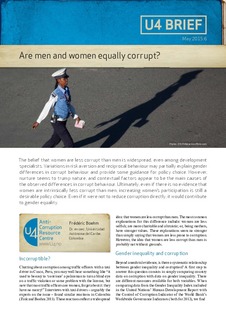| dc.contributor.author | Boehm, Frédéric | |
| dc.date.accessioned | 2018-01-04T08:21:04Z | |
| dc.date.available | 2018-01-04T08:21:04Z | |
| dc.date.issued | 2015-06-01 | |
| dc.identifier | oai:www.cmi.no:5851 | |
| dc.identifier.citation | Bergen: Chr. Michelsen Institute (U4 Brief 2015:6) 4 p. | |
| dc.identifier.uri | http://hdl.handle.net/11250/2475171 | |
| dc.description.abstract | The belief that women are less corrupt than men is widespread, even among development specialists. Variations in risk aversion and reciprocal behaviour may partially explain gender differences in corrupt behaviour and provide some guidance for policy choice. However, nurture seems to trump nature, and contextual factors appear to be the main causes of the observed differences in corrupt behaviour. Ultimately, even if there is no evidence that women are intrinsically less corrupt than men, increasing women’s participation is still a desirable policy choice. Even if it were not to reduce corruption directly, it would contribute to gender equality.
U4 Anti-Corruption Resource Centre Brief 2015:6 (pdf) | |
| dc.language.iso | eng | |
| dc.publisher | Chr. Michelsen Institute | |
| dc.relation | U4 Brief | |
| dc.relation | 2015:6 | |
| dc.relation.ispartof | U4 Brief | |
| dc.relation.ispartofseries | U4 Brief 2015:6 | |
| dc.relation.uri | https://www.cmi.no/publications/5851-are-men-and-women-equally-corrupt | |
| dc.subject | Aid | |
| dc.title | Are men and women equally corrupt? | |
| dc.type | Report | |
